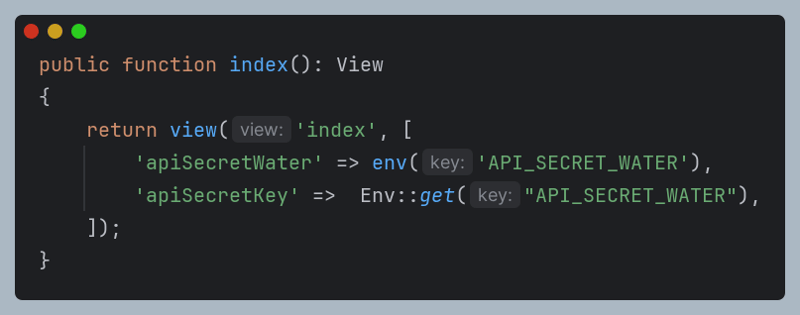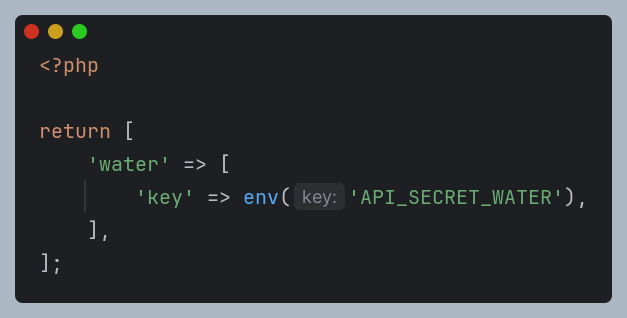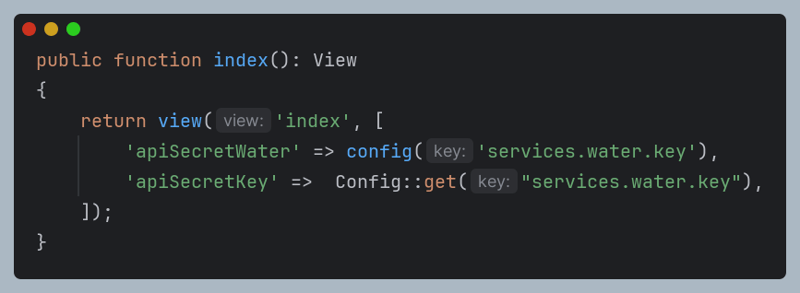 Front page > Programming > Hours is an environment variable, I will use ENV. Calm down, calm down, let me tell you something first
Front page > Programming > Hours is an environment variable, I will use ENV. Calm down, calm down, let me tell you something first
Hours is an environment variable, I will use ENV. Calm down, calm down, let me tell you something first
We are always in a rush and wanting to develop as quickly as possible, and we often end up adopting old habits and building old software, an item that we can improve a lot is this little thing called environment, let's understand a little more about that.
First of all, I would like to show here the focus on the concept of configurations for laravel, I will not worry about the remaining patterns, such as resources or others like that.
1 - Let's seek knowledge!
A while ago I heard that I couldn't do this ENV pass within my crazy codes, I was like; wow
So the purpose is to understand the reasons, because this way, we can make better decisions as engineers.
1.1 - Correct way or a point of view?
So come on little future master, let's put a value in an environment variable so we can play around, so let's call it:

Let's go to the first point, great decision to place this configuration as an environment variable, this way you make everything easier to manage different environments (Production, approval, If you have one? ) and much safer, because this value It won't be exposed when you do that naughty git push in your repository (git/bitbucket), can you imagine your water secret being leaked on the internet, how sad.
And to retrieve this value in Laravel we can use the env() method or also use another package such as Support from Illuminate (it reminds me of minions, I don't know why? )

env: Laravel Helper ( Which uses Env::get )
Env::get: Env class from the Support Illuminate package
Wow, it's ready, so why keep inventing fashion? The truth is that this is not a good idea, I will explain why soon, stay with me.
For the different solution, we can mention the configuration files that will retrieve the value of the environment created, so the configuration file is centralized and come on, seriously! much better for reading code.
In this specific situation you can already use the existing config file, called services.php, but nothing prevents you from creating a file for your specific context.
In the path config/services.php

And so we will call it in the code as follows:

2 - Cool, but why should I use configs to retrieve variables and not just fetch them directly?
I'll try to show some reasons:
2.1 - Increased performance and better use of IO
Think about the following situation, do you have files in production that will be accessed all the time, carrying out considerable IO, which will increase machine resources and depending on the situation, system slowdowns? (And believe me, until you actually find the problem, you will go through things that will question all your knowledge)
When we talk about the production environment, it is recommended that you cache your beautiful configuration files, with Laravel you can use artisan
php artisan config:cache
This beautiful command takes all the configuration files and their respective values and compiles them into a single php file, which increases performance. This is due to the fact that the IO numbers are reduced to 1
Curiosity: When you use this command, env() starts to return NULL because it disables this function. So if from "Neida" a env() yours stopped working, that's it.
Env() Perform IO operations and they are expensive and slow.
It is best to do this operation once at the beginning of the application rather than having to perform the operation every time you need an env.
2.2 - Organization and standardization in the best possible way
You can easily keep all your settings as you want. You can put the name of the dog you want, create a folder and structure all the arrays as you want too, this will make the structure cleaner (please use in moderation)
For example:
Look at this key:

and now look at this key:

In my humble opinion the 1st is much better.
And besides, you can have your similar configurations in the correct and centralized place without having to place them "randomly" in your code, and I really like this idea of structuring the array that makes total sense for the application.
And guidance for new developers is much simpler, as you can tell them where and how to make a new configuration.
Keep it simple, be the difference!
Thank you for everything so far.
Source:
Laravel 11 Documentation Configuration
-
 Why Was DOMSubtreeModified Deprecated in DOM Level 3 and What Are the Alternatives?Deprecation of DOMSubtreeModified Event in DOM Level 3The DOMSubtreeModified event, once a fundamental element in tracking changes within a document&#...Programming Published on 2024-11-08
Why Was DOMSubtreeModified Deprecated in DOM Level 3 and What Are the Alternatives?Deprecation of DOMSubtreeModified Event in DOM Level 3The DOMSubtreeModified event, once a fundamental element in tracking changes within a document&#...Programming Published on 2024-11-08 -
 Does setting a PDO connection to NULL truly close the connection and free up resources?Closing PDO ConnectionsIn PHP, there are two popular database connection interfaces: MySQLi and PDO. While both serve similar purposes, they handle co...Programming Published on 2024-11-08
Does setting a PDO connection to NULL truly close the connection and free up resources?Closing PDO ConnectionsIn PHP, there are two popular database connection interfaces: MySQLi and PDO. While both serve similar purposes, they handle co...Programming Published on 2024-11-08 -
 Dynamic Data Management: Understanding the Data Property in Vue.jsVue.js is one of the most popular JavaScript frameworks for developing modern web applications. It offers an effective way to create interactive and d...Programming Published on 2024-11-08
Dynamic Data Management: Understanding the Data Property in Vue.jsVue.js is one of the most popular JavaScript frameworks for developing modern web applications. It offers an effective way to create interactive and d...Programming Published on 2024-11-08 -
 How to Efficiently Check for List Element Presence in a Python String?Checking List Element Presence in a String in PythonOne common task in Python programming is verifying whether a string includes an element from a giv...Programming Published on 2024-11-08
How to Efficiently Check for List Element Presence in a Python String?Checking List Element Presence in a String in PythonOne common task in Python programming is verifying whether a string includes an element from a giv...Programming Published on 2024-11-08 -
 How Does \'window.JSON\' Provide Native JSON Support in Modern Browsers?Browser Native JSON Support: The window.JSON ObjectThe window.JSON object provides native JSON parsing and serialization capabilities for modern web b...Programming Published on 2024-11-08
How Does \'window.JSON\' Provide Native JSON Support in Modern Browsers?Browser Native JSON Support: The window.JSON ObjectThe window.JSON object provides native JSON parsing and serialization capabilities for modern web b...Programming Published on 2024-11-08 -
 How to Append Tags Effectively in JavaScript?Programming Published on 2024-11-08
How to Append Tags Effectively in JavaScript?Programming Published on 2024-11-08 -
 Do Interfaces Inherit from the Object Class in Java?Interfaces and Object Class: Inheritance and Method InvocationIn Java, interfaces offer a means of defining contracts that classes can implement. When...Programming Published on 2024-11-08
Do Interfaces Inherit from the Object Class in Java?Interfaces and Object Class: Inheritance and Method InvocationIn Java, interfaces offer a means of defining contracts that classes can implement. When...Programming Published on 2024-11-08 -
 Python: Interesting Code PatternsI work mostly with Python and review code on almost daily basis. In our code base formatting & linting is handled by CI jobs using black & mypy. So, w...Programming Published on 2024-11-08
Python: Interesting Code PatternsI work mostly with Python and review code on almost daily basis. In our code base formatting & linting is handled by CI jobs using black & mypy. So, w...Programming Published on 2024-11-08 -
 Using Redis for Caching in Laravel: A Step-by-Step GuideIntroduction Laravel is, without fear of contradiction, the most popular PHP framework, and among the most popular within web development. Re...Programming Published on 2024-11-08
Using Redis for Caching in Laravel: A Step-by-Step GuideIntroduction Laravel is, without fear of contradiction, the most popular PHP framework, and among the most popular within web development. Re...Programming Published on 2024-11-08 -
 Unlock the Power of Real-Time UI: A Beginner&#s Guide to Streaming Data with React.js, gRPC, Envoy, and GolangWritten by Naveen M Background As part of our Kubernetes platform team, we face the constant challenge of providing real-time visibility into ...Programming Published on 2024-11-08
Unlock the Power of Real-Time UI: A Beginner&#s Guide to Streaming Data with React.js, gRPC, Envoy, and GolangWritten by Naveen M Background As part of our Kubernetes platform team, we face the constant challenge of providing real-time visibility into ...Programming Published on 2024-11-08 -
 Build Your Own Operating System (Really!): C Programming for BeginnersBuild your own operating system: Install a C compiler and tools such as MinGW-w64. Write a bootloader using assembly language to load the kernel. Crea...Programming Published on 2024-11-08
Build Your Own Operating System (Really!): C Programming for BeginnersBuild your own operating system: Install a C compiler and tools such as MinGW-w64. Write a bootloader using assembly language to load the kernel. Crea...Programming Published on 2024-11-08 -
 How can I replicate Python\'s startswith() and substring-to-integer functionality in C++?Checking for Prefix String Existence and Converting a Substring to Integer in C A user seeks guidance on implementing Python's string prefix chec...Programming Published on 2024-11-08
How can I replicate Python\'s startswith() and substring-to-integer functionality in C++?Checking for Prefix String Existence and Converting a Substring to Integer in C A user seeks guidance on implementing Python's string prefix chec...Programming Published on 2024-11-08 -
 How can I prevent overlapping annotations in Matplotlib visualizations?Overlapping Annotations in MatplotlibMatplotlib visualizations often encounter the issue of overlapping annotations, leading to cluttered and difficul...Programming Published on 2024-11-08
How can I prevent overlapping annotations in Matplotlib visualizations?Overlapping Annotations in MatplotlibMatplotlib visualizations often encounter the issue of overlapping annotations, leading to cluttered and difficul...Programming Published on 2024-11-08 -
 How Can I Improve My Database Performance? A Guide to Essential Resources for Major EnginesThe Essential Guide to Database Performance Tuning ResourcesDatabase performance tuning is crucial for optimizing the efficiency and responsiveness of...Programming Published on 2024-11-08
How Can I Improve My Database Performance? A Guide to Essential Resources for Major EnginesThe Essential Guide to Database Performance Tuning ResourcesDatabase performance tuning is crucial for optimizing the efficiency and responsiveness of...Programming Published on 2024-11-08 -
 Franken UI: A Powerful HTML-First UI Component LibraryFranken UI is an open-source library that offers a comprehensive set of UI components, designed to be both HTML-first and Tailwind CSS-friendly. Wheth...Programming Published on 2024-11-08
Franken UI: A Powerful HTML-First UI Component LibraryFranken UI is an open-source library that offers a comprehensive set of UI components, designed to be both HTML-first and Tailwind CSS-friendly. Wheth...Programming Published on 2024-11-08
Study Chinese
- 1 How do you say "walk" in Chinese? 走路 Chinese pronunciation, 走路 Chinese learning
- 2 How do you say "take a plane" in Chinese? 坐飞机 Chinese pronunciation, 坐飞机 Chinese learning
- 3 How do you say "take a train" in Chinese? 坐火车 Chinese pronunciation, 坐火车 Chinese learning
- 4 How do you say "take a bus" in Chinese? 坐车 Chinese pronunciation, 坐车 Chinese learning
- 5 How to say drive in Chinese? 开车 Chinese pronunciation, 开车 Chinese learning
- 6 How do you say swimming in Chinese? 游泳 Chinese pronunciation, 游泳 Chinese learning
- 7 How do you say ride a bicycle in Chinese? 骑自行车 Chinese pronunciation, 骑自行车 Chinese learning
- 8 How do you say hello in Chinese? 你好Chinese pronunciation, 你好Chinese learning
- 9 How do you say thank you in Chinese? 谢谢Chinese pronunciation, 谢谢Chinese learning
- 10 How to say goodbye in Chinese? 再见Chinese pronunciation, 再见Chinese learning
























